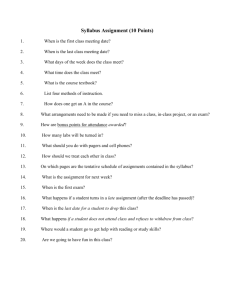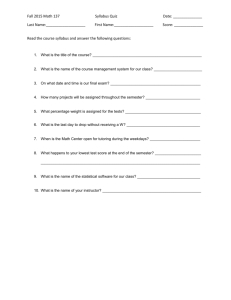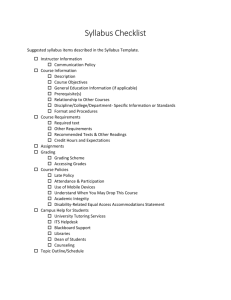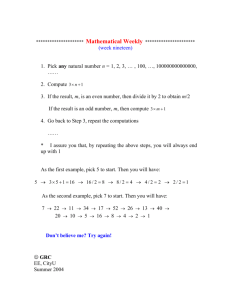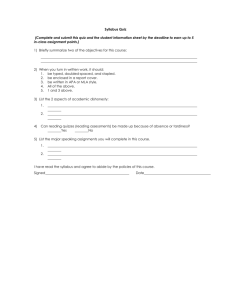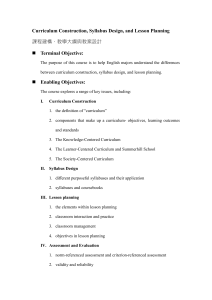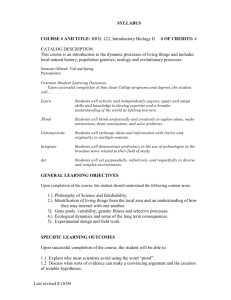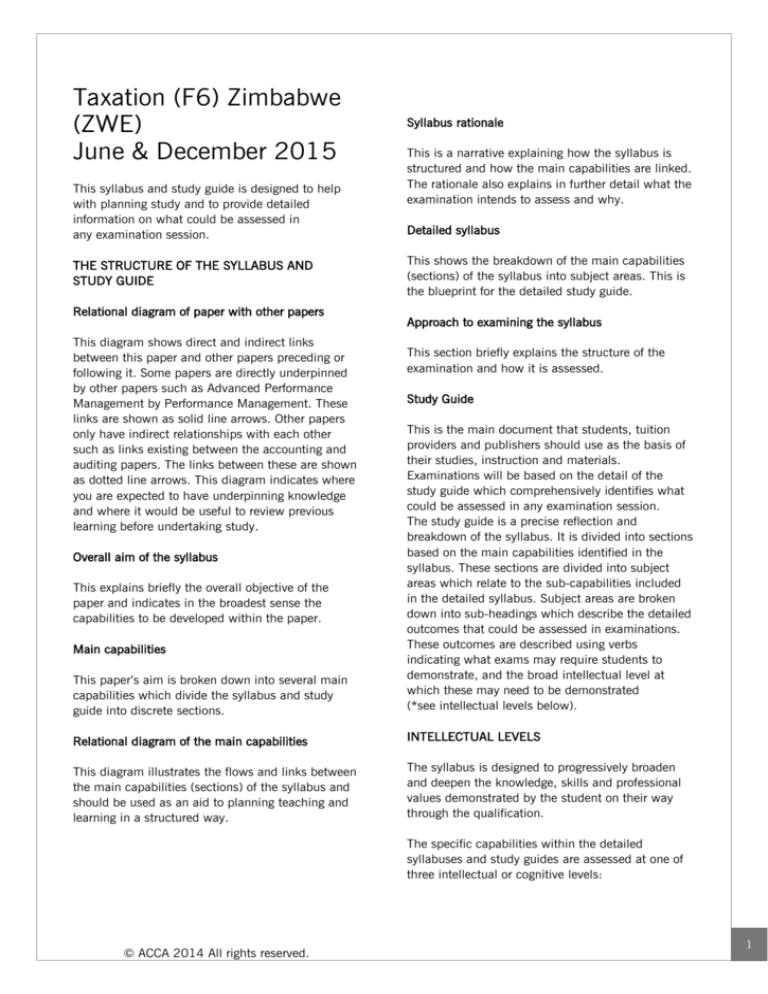
Taxation (F6) Zimbabwe
(ZWE)
June & December 2015
This syllabus and study guide is designed to help
with planning study and to provide detailed
information on what could be assessed in
any examination session.
THE STRUCTURE OF THE SYLLABUS AND
STUDY GUIDE
Relational diagram of paper with other papers
This diagram shows direct and indirect links
between this paper and other papers preceding or
following it. Some papers are directly underpinned
by other papers such as Advanced Performance
Management by Performance Management. These
links are shown as solid line arrows. Other papers
only have indirect relationships with each other
such as links existing between the accounting and
auditing papers. The links between these are shown
as dotted line arrows. This diagram indicates where
you are expected to have underpinning knowledge
and where it would be useful to review previous
learning before undertaking study.
Syllabus rationale
This is a narrative explaining how the syllabus is
structured and how the main capabilities are linked.
The rationale also explains in further detail what the
examination intends to assess and why.
Detailed syllabus
This shows the breakdown of the main capabilities
(sections) of the syllabus into subject areas. This is
the blueprint for the detailed study guide.
Approach to examining the syllabus
This section briefly explains the structure of the
examination and how it is assessed.
Study Guide
This paper’s aim is broken down into several main
capabilities which divide the syllabus and study
guide into discrete sections.
This is the main document that students, tuition
providers and publishers should use as the basis of
their studies, instruction and materials.
Examinations will be based on the detail of the
study guide which comprehensively identifies what
could be assessed in any examination session.
The study guide is a precise reflection and
breakdown of the syllabus. It is divided into sections
based on the main capabilities identified in the
syllabus. These sections are divided into subject
areas which relate to the sub-capabilities included
in the detailed syllabus. Subject areas are broken
down into sub-headings which describe the detailed
outcomes that could be assessed in examinations.
These outcomes are described using verbs
indicating what exams may require students to
demonstrate, and the broad intellectual level at
which these may need to be demonstrated
(*see intellectual levels below).
Relational diagram of the main capabilities
INTELLECTUAL LEVELS
This diagram illustrates the flows and links between
the main capabilities (sections) of the syllabus and
should be used as an aid to planning teaching and
learning in a structured way.
The syllabus is designed to progressively broaden
and deepen the knowledge, skills and professional
values demonstrated by the student on their way
through the qualification.
Overall aim of the syllabus
This explains briefly the overall objective of the
paper and indicates in the broadest sense the
capabilities to be developed within the paper.
Main capabilities
The specific capabilities within the detailed
syllabuses and study guides are assessed at one of
three intellectual or cognitive levels:
© ACCA 2014 All rights reserved.
1
Level 1: Knowledge and comprehension
Level 2: Application and analysis
Level 3: Synthesis and evaluation
subject area headings depending on the nature of
the subject and how these areas have been broken
down.
Very broadly, these intellectual levels relate to the
three cognitive levels at which the Knowledge
module, the Skills module and the Professional level
are assessed.
GUIDE TO EXAM STRUCTURE
Each subject area in the detailed study guide
included in this document is given a 1, 2, or
3 superscript, denoting intellectual level, marked at
the end of each relevant line. This gives an
indication of the intellectual depth at which an area
could be assessed within the examination. However,
while level 1 broadly equates with the Knowledge
module, level 2 equates to the Skills module and
level 3 to the Professional level, some lower level
skills can continue to be assessed as the student
progresses through each module and level. This
reflects that at each stage of study there will be a
requirement to broaden, as well as deepen
capabilities. It is also possible that occasionally
some higher level capabilities may be assessed at
lower levels.
The Fundamentals level examinations contain
100% compulsory questions to encourage
candidates to study across the breadth of each
syllabus.
LEARNING HOURS AND EDUCATION
RECOGNITION
The Professional level papers are all three-hour
paper based examinations, all containing two
sections. Section A is compulsory, but there will be
some choice offered in Section B.
The ACCA qualification does not prescribe or
recommend any particular number of learning hours
for examinations because study and learning
patterns and styles vary greatly between people and
organisations. This also recognises the wide
diversity of personal, professional and educational
circumstances in which ACCA students find
themselves.
As a member of the International Federation of
Accountants, ACCA seeks to enhance the education
recognition of its qualification on both national and
international education frameworks, and with
educational authorities and partners globally. In
doing so, ACCA aims to ensure that its qualifications
are recognized and valued by governments,
regulatory authorities and employers across all
sectors. To this end, ACCA qualifications are
currently recognized on the education frameworks in
several countries. Please refer to your national
education framework regulator for further
information.
Each syllabus contains between 23 and 35 main
2
© ACCA 2014 All rights reserved.
The structure of examinations varies within and
between modules and levels.
The Knowledge module is assessed by equivalent
two-hour paper based and computer based
examinations.
The Skills module examinations F5-F9 are all paper
based three-hour papers containing a mix of
objective and longer type questions. The Corporate
and Business Law (F4) paper is a two-hour
computer based objective test examination which is
also available as a paper based version from the
December 2014 examination sitting.
For all three hour examination papers, ACCA has
introduced 15 minutes reading and planning time.
This additional time is allowed at the beginning of
each three-hour examination to allow candidates to
read the questions and to begin planning their
answers before they start writing in their answer
books. This time should be used to ensure that all
the information and exam requirements are properly
read and understood.
During reading and planning time candidates may
only annotate their question paper. They may not
write anything in their answer booklets until told to
do so by the invigilator.
The Essentials module papers all have a Section A
containing a major case study question with all
requirements totalling 50 marks relating to this
case. Section B gives students a choice of two from
three 25 mark questions.
Section A of both the P4 and P5 Options papers
contain one 50 mark compulsory question, and
Section B will offer a choice of two from three
questions each worth 25 marks each.
Section A of each of the P6 and P7 Options papers
contains 60 compulsory marks from two questions;
question 1 attracting 35 marks, and question 2
attracting 25 marks. Section B of both these
Options papers will offer a choice of two from three
questions, with each question attracting 20 marks.
All Professional level exams contain four
professional marks.
The pass mark for all ACCA Qualification
examination papers is 50%.
GUIDE TO EXAMINATION ASSESSMENT
ACCA reserves the right to examine anything
contained within the study guide at any examination
session. This includes knowledge, techniques,
principles, theories, and concepts as specified.
For the tax papers, ACCA will publish examinable
documents, or tax rates and allowances tables, once
a year to indicate exactly what legislation could
potentially be assessed within identified
examination sessions. These should be read in
conjunction with the information below.
For CYP tax papers, June and December
examinations will be based on regulation or
legislation published in the Official Gazette of the
Republic of Cyprus (“the Gazette”) on or before 30
September. I.e. June and December 2015 papers
will be based on regulation or legislation published
in the Official Gazette of the Republic of Cyprus
(“the Gazette”) on or before 30 September 2014.
For CZE tax papers, December and June
examinations will be based on legislation passed
before the previous 31 May. I.e. December 2014
and June 15 papers will be based on legislation in
force at 31 May 2014.
For VNM tax papers, June and December
examinations will be based on legislation passed
before the previous 31 December. I.e. June and
December 2015 papers will be based on legislation
passed by 31 December 2014.
Tax papers for the following variants:
BWA, CHN, HUN, HKG, IRL, LSO, MWI, MLA,
POL, PKN, ROM, RUS, ZAF, ZWE.
The June and December examinations will be based
on legislation passed before the previous 30
September. I.e. June and December 2015 papers
will be based on legislation passed by 30
September 2014.
For UK tax papers, examinations falling within the
financial year 1 April to 31 March will examine the
Finance Act which was passed in the previous July.
I.e. Exams falling in the period 1 April 2015 to 31
March 2016 will examine the Finance Act 2014.
For SGP tax papers, examinations falling within the
year 1 April to 31 March will be based on
legislation passed before the previous 30
September. I.e. examinations falling in the year 1
April 2015 to 31 March 2016 will be based on
legislation passed by 30 September 2014.
For MYS tax papers, examinations falling within the
year 1 October to 30 September will be based on
legislation passed before the previous 31 March.
I.e. examinations falling in the year 1 October 2014
to 30 September 2015 will be based on legislation
passed before the previous 31 March 2014.
© ACCA 2014 All rights reserved.
3
Syllabus
MAIN CAPABILITIES
After completing this examination paper students
should be able to:
(F6) (ZWE)
A
Explain the operation and scope of the
Zimbabwe tax system and its administration
B
Explain and compute the income tax liabilities
of individuals
C
Explain and compute the corporation tax
liabilities of individual companies and groups
of companies
D
Explain and compute the capital gains tax
liabilities of individuals and companies
E
Explain and compute the effect of national
social security (NSSA) and pension/benefit fund
contributions on employees, employers and the
self employed
F
Explain and compute the effects of value added
tax on incorporated and unincorporated
businesses
AIM
To develop knowledge and skills relating to the
Zimbabwe tax system as applicable to individuals,
single companies and groups of companies.
RELATIONAL DIAGRAM OF MAIN CAPABILITIES
The Zimbabwe tax system and its administration (A)
The UK tax Ta (A)
Income tax (B)
VAT (F)
4
© ACCA 2014 All rights reserved.
Corporation tax (C)
Capital gains tax(D)
National social security and pension/benefit
fund contributions (E)
RATIONALE
This syllabus introduces candidates to the subject of
taxation and provides the core knowledge of the
underlying principles and major technical areas of
taxation, as they affect the activities of individuals
and businesses.
In this syllabus, candidates are introduced to the
rationale behind and the functions of the tax
system. The syllabus then considers the separate
taxes that an accountant would need to have a
detailed knowledge of, such as income tax from self
employment, employment and investments; the
corporation tax liability of individual companies and
groups of companies; the national social security
and pension/benefit fund contribution liabilities of
both employed and self employed persons; the
value added tax liability of businesses; and the
capital gains tax liabilities of both individuals and
companies
Having covered the core areas of the basic taxes,
the candidate should be able to compute tax
liabilities, explain the basis of their calculations,
apply tax planning techniques for individuals and
companies and identify the compliance issues for
each major tax through a variety of business and
personal scenarios and situations.
1.
The scope of income tax
2.
Income from employment
3.
Income from self-employment
4.
5.
Property and investment income
The comprehensive computation of taxable
income and income tax liability
6.
The use of exemptions and reliefs in deferring
and minimising income tax liabilities
C
Corporation tax liabilities
1.
The scope of corporation tax
2.
Profits chargeable to corporation tax
3.
The comprehensive computation of corporation
tax liability
4.
The effect of a group corporate structure for
corporation tax purposes
5.
The use of exemptions and reliefs in deferring
and minimising corporation tax liabilities
D
Capital gains tax liabilities
DETAILED SYLLABUS
A
1.
1.
The scope of the taxation of capital gains
The Zimbabwe tax system and its
administration
2.
The basic principles of computing gains and
losses
The overall function and purpose of taxation in
a modern economy
3.
Gains and losses on the disposal of
immovable property and marketable securities
4.
The computation of the capital gains tax
payable by individuals and companies
5.
The use of exemptions and reliefs in deferring
and minimising tax liabilities arising on the
disposal of specified assets for capital gains tax
purposes
E
National social security and pension/benefit
fund contributions
1.
The scope of national social security and
pension/benefit fund contributions
2.
Principal sources of revenue law and practice
3.
The systems for self-assessment and the
making of returns
4.
The time limits for the submission of
information, claims and payment of tax,
including payments on account
5.
The procedures relating to enquiries, appeals/
objections and disputes
6.
B
Penalties for non-compliance
Income tax liabilities
© ACCA 2014 All rights reserved.
5
APPROACH TO EXAMINING THE SYLLABUS
2.
3.
F.
The computation of national social security,
pension/benefit fund contributions
Computation of allowable national social
security and pension/benefit fund contributions
for personal pension schemes and occupational
pension schemes
The syllabus is assessed by a three-hour paper
based examination.
The paper will be predominantly computational
and all questions are compulsory.
Section A of the exam comprises 15 multiple
choice questions of 2 marks each.
Value added tax
1.
The scope of value added tax (VAT)
2.
The VAT registration requirements
3.
The computation of VAT liabilities
Section B of the exam comprises four 10 mark
questions and two 15 mark questions.
The two 15 mark questions will focus on income
tax (syllabus area B) and corporation tax (syllabus
area C).
The section A questions and the other questions
in section B can cover any areas of the syllabus.
6
© ACCA 2014 All rights reserved.
Study Guide
A
1.
a)
b)
c)
a)
THE ZIMBABWE TAX SYSTEM AND ITS
ADMINISTRATION
Recognise the time limits that apply to the
filing of returns and the making of claims.[2]
b)
The overall function and purpose of taxation
in a modern economy
Recognise the due dates for the payment of tax
under the assessment system.[2]
c)
Describe the purpose (economic, social etc) of
taxation in a modern economy.[2]
Compute provisional and quarterly payments of
tax.[2]
d)
Identify the different types of capital and
revenue tax.[1]
List the information and records that taxpayers
need to retain for tax purposes.[1]
5.
Explain the difference between direct and
indirect taxation.[2]
The procedures relating to enquiries,
appeals/objections and disputes
a)
Explain the circumstances in which ZIMRA
can enquire into an assessment tax return.[2]
b)
Explain the procedures for dealing with
appeals/objections and disputes.[1]
6.
Penalties for non-compliance
a)
Calculate interest on overdue tax.[2]
b)
State the penalties that can be charged.[2]
B
INCOME TAX LIABILITIES
1.
The scope of income tax
a)
Explain how the residence of an individual is
determined.[1]
2.
Principal sources of revenue law and practice
a)
Describe the overall structure of the Zimbabwe
tax system.[1]
b)
State the different sources of revenue law.[1]
c)
Appreciate the interaction of the Zimbabwe
tax system with that of other tax jurisdictions.[2]
d)
Explain the difference between tax avoidance
and tax evasion.[1]
e)
Explain the need for an ethical and professional
approach.[2]
Excluded topics
Specific anti-avoidance legislation
Assurance/insurance tax legislation
Excluded topics
3. The systems for assessment and the making of
returns
a)
b)
4.
Explain and apply the features of the
assessment system as it applies to
individuals and companies.[2]
Explain the quarterly payment date system
(QPD’s) as it applies to companies and selfemployed individuals.[2]
The time limits for the submission of
information, claims and payment of tax,
including payments on account
© ACCA 2014 All rights reserved.
Income from trusts and settlements.
2.
Income from employment
a)
Recognise the factors that determine whether
an engagement is treated as employment or
self-employment.[2]
b)
Recognise the basis of assessment for
employment income.[2]
c)
Compute the taxable income.[2]
7
d)
Recognise the exemptions and allowable
deductions.[2]
e)
Compute the value of taxable benefits.[2]
f)
Explain the PAYE system.[1]
v) Define an industrial building and a
commercial building for capital allowance
purposes [1]
vi) Compute industrial building allowance and
commercial buildings allowance for new
and second-hand buildings.[2]
Excluded topics
Share and share option incentive schemes
for employees.
Termination payments
3
Income from self-employment
a)
Recognise the basis of assessment for selfemployment income.[2]
b)
Recognise the expenditure that is allowable in
calculating the tax-adjusted trading profit.[2]
c)
d)
e)
g)
Incentive allowances
h)
Relief for trading losses
i) Understand how trading losses can be
carried forward [2]
ii) Explain how trading losses can be carried
forward following the incorporation of a
business [2]
iii) Understand how trading losses can be
claimed against total trading income [2]
Recognise the relief that can be obtained for
pre-trading expenditure.[2]
Compute the taxable income on
commencement and on cessation.[2]
iv) Explain the relief for trading losses in the
early years of a trade.[1]
i)
Change of accounting date
ii) Recognise the special deductions available
to farmers
ii) State the conditions that must be met for a
change of accounting date to be valid [1]
iii) Compute farming taxable income
iii) Compute the taxable income on a change
of accounting date.[2]
iv) Understand how relief for farming losses is
given.
Capital allowances
j)
Partnerships
i) Define plant and machinery for capital
allowances purposes [1]
i) Explain how a partnership is assessed to
tax [2]
ii) Compute annual wear and tear (reducing
balance method) allowances and special
initial allowances [2]
ii) Compute the taxable income for each
partner following a change in the profit
sharing ratio [2]
iii) Compute capital allowances for commercial
and passenger motor vehicles [2]
iii) Compute the taxable income for each
partner following a change in the
membership of the partnership [2]
iv) Compute the recoupment of capital
allowances on an asset’s disposal [2]
8
[2]
i) Apply standard values to the valuation of
stock
i) Recognise the factors that will influence the
choice of accounting date [2]
f)
Farmers
© ACCA 2014 All rights reserved.
iv) Describe the loss relief claims that are
available to partners.[2]
a)
Explain and compute the relief given for
contributions to personal pension schemes.[2]
k) Explain the obligation to withhold tax at
source when making payments to both
residents and non-residents .[2]
b)
Describe the relief given for contributions to
occupational pension schemes.[1]
4.
Property and investment income
c)
a)
Compute property business taxable income.[2]
Explain and apply the exemptions from and
reductions in tax payable available to taxpayers
in industrial parks, and under BOOT
arrangements.[2]
b)
Compute the taxation of premiums
receivable/payable in conjunction to a lease.[2]
c)
Distinguish between exempt and taxable
interest income.[2]
d)
Compute the tax payable on savings income.[2]
e)
Compute the tax payable on dividend
income.[2]
f)
Understand how property and investment
business losses can be carried forward.[2]
5
a)
b)
Excluded topics
The conditions that must be met in order
for a pension scheme to obtain approval
from the Zimbabwe Revenue Authority
(ZIMRA)
C
CORPORATION TAX LIABILITIES
1.
The scope of corporation tax
a)
Define the terms ‘period of account’,
‘accounting period’, and ‘year of assessment’.[1]
The comprehensive computation of taxable
income and income tax liability
b)
Recognise when an accounting period starts
and when an accounting period finishes.[1]
Prepare a basic income tax computation
involving different types of income.[2]
c)
Explain how the residence of a company is
determined.[2]
Calculate the amount of personal allowance
available to people aged 55 and above.[2]
Excluded topics
Companies in the special economic sectors
of assurance/insurance, banking and
financial institutions and mining
Compute the amount of applicable tax
credits.[2]
Investment companies.
e)
Explain the treatment of donations.[1]
Close companies.
f)
Explain the treatment of income received from
property owned jointly by a married couple.[1]
Companies in receivership or liquidation.
Reorganisations.
The purchase by a company of its own
shares.
Personal service companies
Taxation of Venture capital companies.
c)
Compute the amount of income tax payable
(including AIDS levy).[2]
d)
Excluded topics
6.
Maintenance payments.
The income of minor children.
The use of exemptions and reliefs in deferring
and minimising income tax liabilities
© ACCA 2014 All rights reserved.
9
2.
Profits chargeable to corporation tax
a)
Recognise gross income.[2]
b)
Recognise the expenditure that is allowable in
calculating taxable business income.[2]
c)
d)
c)
Explain the obligation to withhold tax at source
when making payments to both residents and
non-residents .[2]
Explain how relief can be obtained for pretrading expenditure.[1]
4.
The effect of a group corporate structure for
corporation tax purposes
Compute capital allowances (as for
individual/personal income tax).[2]
a)
Explain and apply the relief available for
transfers of assets between companies under
common control.[2]
b)
Calculate double taxation relief for withholding
tax and underlying tax.[2]
Explain the basic principles of the transfer
pricing rules.[2]
e)
Compute investment incentives (as for
individual/personal income tax).[2]
f)
Compute property business taxable income.[2]
g)
Explain the treatment of interest paid and
received.[1]
c)
h)
Explain the treatment of donations.[2]
Excluded topics
i)
Understand how assessed trading losses can
be carried forward.[2]
Relief for trading losses incurred by an
overseas subsidiary.
j)
Understand how assessed trading losses can
be claimed against income of the current
accounting periods.[2]
The anti-avoidance provisions where
arrangements exist for a company to leave
a group.
k)
Recognise the factors that will influence the
choice of assessed loss relief claim.[2]
Foreign companies trading in Zimbabwe.
Expense relief in respect of overseas tax.
l)
Explain how relief for a property business
assessed loss is given.[1]
Transfer pricing transactions not involving
an overseas company.
m) Compute the taxable income chargeable to
corporation tax.[2]
Excluded topics
3.
a)
b)
10
in industrial parks, and under BOOT
arrangements.[2]
5. The use of exemptions and reliefs in deferring
and minimising corporation tax liabilities (The
use of such exemptions and reliefs is implicit
within all of the above sections 1 to 4 of part C
of the syllabus, concerning corporation tax)
Relief for intangible assets.
The comprehensive computation of
corporation tax liability
Compute the corporation tax liability (including
AIDS levy).[2]
Explain and apply the exemptions from and
reductions in tax payable available to taxpayers
© ACCA 2014 All rights reserved.
D
CAPITAL GAINS
1.
The scope of the taxation of capital gains
a)
Describe the scope of capital gains tax.[2]
b)
List those assets which are exempt.[1]
c)
List those persons which are exempt. .[1]
Excluded topics
2.
a)
b)
c)
d)
Excluded topics
Partnership capital gains.
The basic principles of computing gains and
losses.
4.
The computation of the capital gains tax
payable by individuals and companies
Compute capital gains on specified assets for
both individuals and companies.[2]
a)
Compute the amount of capital gains tax
payable.[2]
Recognise deductible expenditure, including
adjustment for inflation.[2]
b)
Understand the application of capital gains
withholding tax.[2]
Explain the treatment of capital losses for both
individuals and companies.[1]
5.
The use of exemptions and reliefs in deferring
and minimising tax liabilities arising on the
disposal of specified assets
a)
Explain and apply rollover relief as it applies to
individuals and companies.[2]
b)
Explain and apply the relief that is available
upon the transfer of assets by an individual to a
company which he controls.[2]
c)
Explain and apply the relief available for
transfers of assets between companies under
common control.[2]
d)
Explain and apply the relief available where the
purchase price is paid by instalments.[2]
Explain the treatment of transfers between a
husband and wife.[2]
e)
Compute the amount of allowable expenditure
for a part disposal.[2]
f)
Explain the treatment where an asset is
damaged, lost or destroyed, and the
implications of receiving insurance proceeds
and reinvesting such proceeds.[2]
Excluded topics
Assets held at 31 July 1981
Assessed losses in the year of death.
Negligible value claims.
Excluded topics
3.
a)
b)
The disposal of leases and the creation of
sub-leases.
Gains and losses on the disposal of immovable
property and marketable securities
Compute the relief available when a principal
private residence is disposed of between
related parties.[2]
Calculate the capital gain when a principal
private residence has been used for business
purposes.[2]
c)
Calculate the value of quoted shares where
they are disposed of by way of a gift.[2]
d)
Explain the treatment of bonus issues, rights
issues, takeovers and reorganisations.[2]
© ACCA 2014 All rights reserved.
Reinvestment relief.
E
NATIONAL SOCIAL SECURITY AND
PENSION/BENEFIT FUND CONTRIBUTIONS
1.
The scope of the national social security
system
a)
Describe the scope of pension/benefit fund and
national social security contributions.[1]
2.
The computation of national social security and
pension/benefit fund contributions
a)
Compute the contributions payable by
employed persons.[2]
11
b)
Compute the contributions payable by selfemployed persons.[2]
e)
Recognise the circumstances in which input
VAT is non-deductible.[2]
3.
Computation of allowable national social
security and pension/benefit fund contributions
for personal pension schemes and occupational
pension schemes.[2]
f)
Compute the relief that is available for
impairment losses on trade debts.[2]
g)
Explain the circumstances in which the default
penalty, interest and fine will be applied.[1]
F
VALUE ADDED TAX
1.
The scope of value added tax (VAT)
a)
Describe the scope of VAT.[2]
b)
List the principal zero-rated and exempt
supplies.[1]
2.
The VAT registration requirements
a)
Recognise the circumstances in which a person
must register for VAT.[2]
b)
Explain the advantages of voluntary VAT
registration.[2]
c)
Explain the circumstances in which preregistration input VAT can be recovered.[2]
d)
Explain how and when a person can deregister
for VAT.[1]
e)
Explain the four categories of tax period.[1]
Excluded topics
Excluded topics
12
Group registration.
3.
The computation of VAT liabilities
a)
Explain how VAT is accounted for and
administered.[2]
b)
Recognise the tax point when goods or services
are supplied.[2]
c)
List the information that must be given on a
VAT invoice.[1]
d)
Explain and apply the principles regarding the
valuation of supplies.[2]
© ACCA 2014 All rights reserved.
Imports and exports
SUMMARY OF CHANGES TO F6 (ZWE)
ACCA periodically reviews it qualification syllabuses so
that they fully meet the needs of stakeholders such as
employers, students, regulatory and advisory bodies and
learning providers.
The main areas that have been amended in the syllabus
are shown in Table 1 below:
Table 1 – Amendments to F6 (ZWE)
Section and subject area
Enlarged syllabus area A
B3 – Income from self-employment
C3 - The comprehensive computation of corporation
tax liability
© ACCA 2014 All rights reserved.
Syllabus content
Syllabus area G (the obligations of the taxpayer
and/or their agents) has been combined with
syllabus area A to create an enlarged syllabus area
A (the Zimbabwe tax system and its administration).
New part (k) on the obligation to withhold tax at source
added
New part (c) on the obligation to withhold tax at source
added
13


